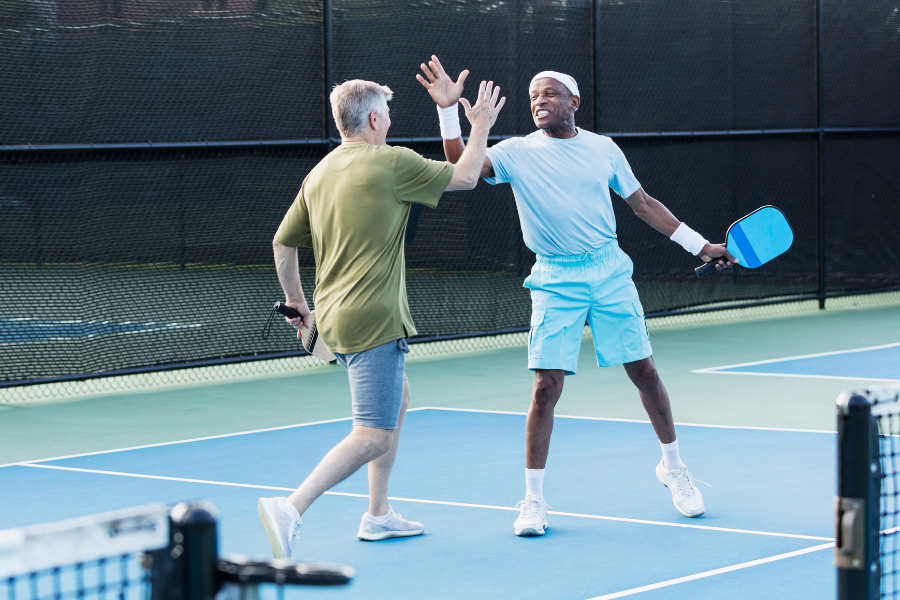In June 2023, analysts at UBS estimated that pickleball injuries could result in $250 million to $500 in medical costs by the end of the year. They also estimated that there would be around 66,760 trips to the emergency room and 366.186 outpatient visits. There has been no update to the figures, but they are something to pay attention to.
One reason is believed to be that a third of regular pickleball players are aged 60 and over, and it is relatively easy to learn. Although pickleball has been around since the 1960s, it has grown in popularity over the last few years. According to the Sports and Fitness Industry Association, a record 8.9 million people now play the sport.
What pickleball injuries are we seeing at Bryn Mawr Wellness?
We have seen an uptick in injuries. Injuries are wide-ranging and can include:
• Sprained ankles
• Achilles tendinitis
• Calf strains and tears
• Strained hamstrings
• Knee injuries, including MCL and LCL strain as well as meniscus tears
• Plantar fasciitis
• Groin strain
• Wrist strain and tendinitis
• Rotator cuff injuries
• Tennis (Pickleball) elbow
• Lower back injuries
The wide range of injuries is due to the nature of the game. The lower body is impacted by the running, twisting, and bending motion and the sudden stops, especially when you realize you are about to step foot in ‘the kitchen.’ The upper body is impacted by the quick and repetitive swinging motion and the impact of hitting the ball.
Six ways to avoid pickleball injuries
1. Add in exercise off the pickleball court
You can lessen pickleball injuries by working on balance, flexibility, stamina, and strength. The sudden stop-start of the game and switching of direction can cause falls. You can help prevent this by working on your balance off the court.
Working on your overall flexibility will help with the game’s twisting, running, and swinging motions. Think about working on your spine mobility as well as your shoulder mobility. You should also work on increasing your strength, especially the muscles around your joints. For instance, injuries, such as MCL tears, can be prevented by strengthening the muscles around the knee.
Finally, working on your stamina will help you keep proper technique while playing. The more tired you get, the more likely you are to forget your form, and that’s when injuries can happen. Going for regular walks is one way to improve stamina.
2. Warm up before you play
Always, always, always warm up before you play. Even if you run late or only have a short time to play pickleball, you will never regret taking five minutes to warm up your muscles. When you feel a glisten of sweat on your forehead, you are ready to hit the court.
3. Invest in good equipment
Invest in a pair of sneakers that support your foot and ankle. Ensure they have excellent cushioning and can absorb the impact when you run and jump for a shot. Your Achilles tendon will thank you.
Invest in a good-quality paddle. Consider the weight of the paddle. One that is too heavy can result in shoulder and elbow injuries, as can one that isn’t high-quality and will not absorb the ball’s impact.
Don’t hesitate to ask professionals for help on the sneakers and paddle. That’s what they are there for.
4. Watch your form
As with any sport, improper technique can and will most likely lead to injury. Think about the positioning of your swing and the way you run, jump, and land. Repeated play with improper form will lead to injury. If you find yourself questioning your form, invest in a lesson to make sure you are playing correctly. If it starts to hurt in the middle of your match it’s time to think about how you are playing.
5. Cool down and stretch
Make stretching your muscles after exercise part of your routine. As pickleball is a full-body exercise, be sure to incorporate a range of stretches. Remember to stretch everything from your shoulders down to your legs and ankles.
6. Take a break
If you do pick up an injury, take some time out. A few days’ rest will be much better than aggravating the injury or making it worse. If it doesn’t feel better, seek help from a chiropractor, physical therapist, or medical practitioner.
Getting back on the court after a pickleball injury
Injuries can and do happen. The key is to avoid them and to rest and rehab injuries when they do occur. Work on your strength, flexibility, balance, and stamina outside the court. Warm up and cool down, use the correct equipment, and watch your form.
Avoid the kitchen (yes, we know the lingo), and remember that we are always here to help. Happy pickleball playing.
